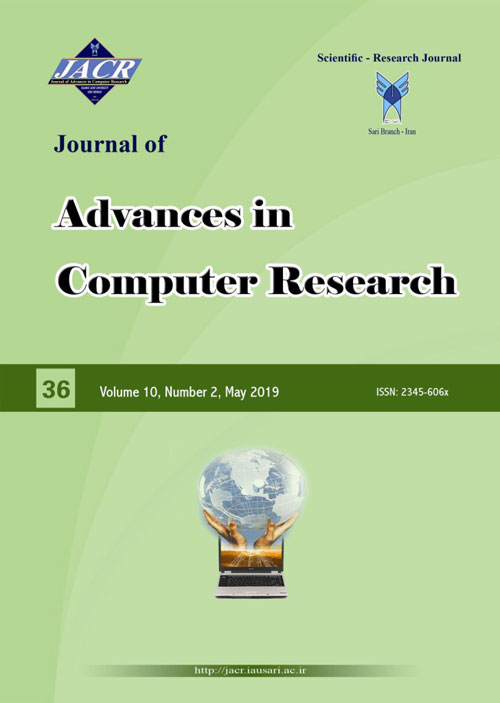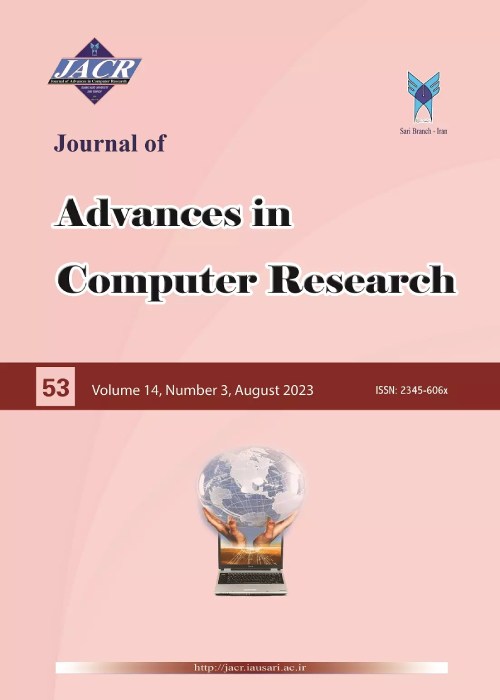فهرست مطالب

Journal of Advances in Computer Research
Volume:10 Issue: 2, Spring 2019
- تاریخ انتشار: 1398/02/11
- تعداد عناوین: 8
-
Pages 1-16Intrusion detection systems are designed to provide security in computer networks, so that if the attacker crosses other security devices, they can detect and prevent the attack process. One of the most essential challenges in designing these systems is the so called curse of dimensionality. Therefore, in order to obtain satisfactory performance in these systems we have to take advantage of appropriate pre-processing steps specially the feature subset selection methods. Since the problem of searching for the optimal feature subset has an intolerable complexity, in this paper we propose a genetic-algorithm-based search method for finding the most relevant subset of features. In order to find the most relevant features, the parallel structure of the genetic algorithm along with the distribution factor of the features is used. The fitness value of each feature subset is computed according to performance of the classifier trained with respect to that subset. In order to evaluate the performance of the proposed method, we use the NSL-KDD dataset which benefits from more real-world intriguing records than other intrusion detection data. The results of our evaluation experiments shows that the proposed method outperforms the prior methods.Keywords: Intrusion Detection Systems, data-mining, Feature Selection, Genetic Algorithm, dataset NSL-KDD
-
Pages 17-30Automatic short answer grading (ASAG) is the automated process of assessing answers based on natural language using computation methods and machine learning algorithms. Development of large-scale smart education systems on one hand and the importance of assessment as a key factor in the learning process and its confronted challenges, on the other hand, have significantly increased the need for an automated system with high flexibility for assessing exams based on texts. Generally, ASAG methods can be categorized into supervised and unsupervised approaches. Supervised approaches such as machine learning and especially deep learning methods require the manually constructed pattern. On the other hands, while in the assessment process, student's answer is compared to an ideal response and scoring is done based on their similarity, semantic relatedness and similarity measures can be considered as unsupervised approaches for this aim. Whereas unsupervised approaches do not require labeled data they are more applicable to real-world problems and are confronted with fewer limitations. Therefore, in this paper, various measures of semantic relatedness and similarity are extensively compared in the application of short answer grading. In the following, an approach is proposed for improving the performance of short answer grading systems based on semantic relatedness and similarity measures which leverages students' answers with the highest score as feedback. Empirical experiments have proved that using students' answers as feedback can considerably improve the precision of semantic relatedness and similarity measures in the automatic assessment of exams with short answers.Keywords: Semantic Relatedness, Short Answer Grading, Latent Semantic Analysis, Explicit Semantic Analysis, deep learning, E-learning system
-
Pages 31-52With advances in technologies, different tumor features have been collected for Breast Cancer (BC) diagnosis. The process of dealing with large data set suffers some challenges which include high storage capacity and time required for accessing and processing. The objective of this paper is to classify BC based on the extracted tumor features and to develop an ADABOOST ensemble Model to extract useful information and diagnose the tumor. In this research work, both homogeneous and heterogeneous ensemble classifiers (combining two different classifiers together) were implemented, and Synthetic Minority Over-Sampling Technique (SMOTE) data mining pre-processing is used to deal with the class imbalance problem and noise in the dataset. In this paper, the proposed method involve two steps. The first step employs SMOTE to reduce the effect of data imbalance in the dataset. The second step involves classifying using decision algorithms (ADTree, CART, REPTree and Random Forest), Naïve Bayes and their Ensembles. The experiment was implemented on WEKA Explore (Weka 3.6). Experimental results show that ADABOOST-Random forest classifies better than other classification algorithms with 82.52% accuracy, followed by Random Forest-CART with 72.73% accuracy while Naïve Bayes classification is the lowest with 35.70% accuracy.Keywords: breast cancer, Adaboost, Synthetic minority over sampling technique, Random forest, Ensemble
-
Pages 53-59This paper introduces a new design of penternary inverter gate based on graphene nanoribbon field effect transistor (GNRFET). The penternary logic is one of Multiple-valued logic (MVL) circuits which are the best substitute for binary logic because of its low power-delay product (PDP) resulting from reduced complexity of interconnects and chip area. GNRFET is preferred over Si-MOSFET for circuit design due to its fantastic thermal, mechanical and electrical properties. For this circuit design, the voltage divisions obtained with resistors. All the circuits are simulated and compared by HSPICE, 15nm GNR Technology with the supply voltage of 0.8V. Simulation results demonstrate that the PDP is about 1e-18. Therefore, MVL design based on GNRFET leads to minimum PDP than other devices such as CNTFET. Furthermore, the transient wave is absolutely accurate. The variation of the figure of merits (FOM) such as power consumption, propagation delay, and PDP is investigated as a function of a number of the ribbon in GNRFET structure.Keywords: GNRFET, Penternary logic, Power-delay product, Inverter
-
Pages 61-74In recent years, the advancement of digital technology has led to an increase in data transmission on the Internet. Security of images is one of the biggest concern of many researchers. Therefore, numerous algorithms have been presented for image encryption. An efficient encryption algorithm should have high security and low search time along with high complexity. DNA encryption is one of the fastest emerging technologies performing based on the concepts of DNA computing and can be used for data storage and transfer. Very high speed and minimum memory and power requirements in the DNA calculations are of the advantages of this new encryption algorithm. In this study, a new encryption algorithm has been proposed for grayscale digital images using DNA algorithm and lattice map function. In the first step, the initial value of the Logistic Map function has been obtained from a 120-bit key using the proposed method, then in the second stage, the original image was encrypted with the Lattice Map function sequence using the logistic map function sequence generated in the previous step and the DNA rules. The results of the simulations showed a high level of resistance and security against statistical attacks, so that the entropy of the proposed method was obtained as 7.9996.Keywords: Chaos Function, Lattice Map, DNA Sequence
-
Pages 75-89One of the most common styles of business today is electronic business, since it is considered as a principal means for financial transactions among advanced countries. In view of the fact that due to the evolution of human knowledge and the increase of expectations following that, traditional marketing in electronic business cannot meet current generation’s needs. In order to survive, organizations have to correct and even change their advertisement strategies along with changes, facts and behaviors of their customers. In order for this and considering unique characteristics of social networks in obtaining and evaluating customer’s behavior, there will a chance for the organization to reach its goals through performing such a business on social networks. In this article, a trust-based recommender system in Social Rating Networks (SRN) is designed in order to recommend an article to the user through receiving user ID and evaluation of related characteristics. A big real data set, Epinions, is used in the database of this system. According to the evaluation performed in this system, 99.01% of users studied the articles recommended by system and an average ratio of articles studied by each test sample to the recommended articles was 87.57%.Keywords: Social Rating Network, trust-based recommender system, Epinions database
-
Pages 91-107Underwater Wireless Sensor Networks (UWSNs) are considered as wireless sensor networks whose main task is to sense underwater events and send information to the sink. This information becomes valuable when the exact location of the occurrence is known. Generally, underwater sensor nodes are not equipped with devices such as the Global Position System (GPS) with the purpose of reducing network costs. Therefore, finding the location of the nodes should be done using another exact method. In this paper, we intend to find the location of the underwater sensor nodes by introducing a new method based on the Cuckoo Optimization Algorithm (COA).We will compare the proposed method with the related methods in terms of the localization error rate and the number of nodes discovered. The results of the comparisons show that the proposed method can greatly reduce the error rate of the localization of the sensor nodes.Keywords: localization Sensor, Underwater Wireless Sensor Networks, Cuckoo Optimization Algorithm, Triangular Method
-
Pages 109-117The timetabling problem consists in scheduling a sequence of courses in times period between teachers and students, satisfying a set of constraints of various types. The problem of University Exam Timetabling problem is one of the complex combined problems that universities worldwide struggle with for several times over the course of the year. The objective in this problem is to assign the student exams to times period and rooms in order to meet a series of constraints. The university exam timetabling problem is of difficult problems due to the very large search space, and innovative algorithms are more used to solve it. Several methods have been suggested to solve this problem so far. For the first time, the aim is to present a new method in the present study for university exams timetabling using an artificial fish-swarm algorithm (AFSA), then compare this method with other algorithms in order to evaluate the efficiency of the proposed method. The simulation results indicated that the proposed method is of high efficiency.Keywords: university Timetable, Exam, artificial fish-swarm algorithm


